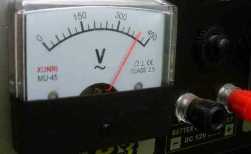Categories: Sharing experience, Practical Electronics
Number of views: 61404
Comments on the article: 0
Three-phase voltage at home - easy!
 According to existing Russian standards, consumers are supplied with single-phase power supply with variable characteristics, that is, with alternating current.
According to existing Russian standards, consumers are supplied with single-phase power supply with variable characteristics, that is, with alternating current.
The rated voltage is 220 volts with a frequency of 50 Hz. But there are such cases that sharply pop up in rural areas and in summer cottages, when we need to connect a three-phase electric device to work.
An example of such a device is a power-saw bench, powerful pumps, electric tractors, various types of threshers and meat grinders, concrete mixers. So where to get these two missing phases? In fact, there is nothing complicated in this and will be on the shoulder of anyone who is more or less versed in electrical engineering and energy.
Usually in such cases, we are advised to purchase a portable generator. But you can do without it, or at least use a cheaper option - a three-phase asynchronous electric motor with a squirrel-cage rotor. In its structure, it is no different from the generator, but it can work both in engine mode and in generator mode. We will use this property for our own purposes.
To achieve this goal, it is necessary to power the winding of only one phase, which is sufficient for the appearance of a stable electromagnetic field and induction of the EMF. But, as you can see, after turning on the engine in this way it does not work! It should be so - he needs help.
To start the engine into operation, it is necessary to untwist its rotor with either hands or turfs for a rope tightly wrapped around the rotor - this is at your discretion. After the first shift, EMF is induced, and hence the current in the remaining phase windings, supporting the operation of the motor. Two missing phases appear on the output terminals, to which the load is connected - our three-phase units.
Since the method is far from time-tested technologies, it has its own nuances and disadvantages that are worth considering. First, keep in mind that it is impossible to use high-power motors with very high inrush currents for these purposes - limit yourself to 4-5 kW motors with the lowest possible speed (it is not recommended to exceed 1000 rpm).
The load can only be connected after the rotor accelerates, having reached the rated values of its rotation speed. Moreover, the load power should be less than the power of our motor phase converter. Practice shows that it is recommended to connect a load of not more than 4000 watts to a 5000 W motor.
Since the engine is still not a generator, it is characterized by instability of the output voltage both in time and in phases. Therefore, it is recommended that you use small transformers with output voltage control, which will automatically equalize the energy indicators before it reaches the devices you connected.
If you decide to use more powerful motors as a converter, then consider how to reduce inrush currents. Usually this will require creating a complex circuit that is not intended to connect a three-phase motor to one phase. So be prepared to fork out for special launch rheostats.
See also at bgv.electricianexp.com
:
